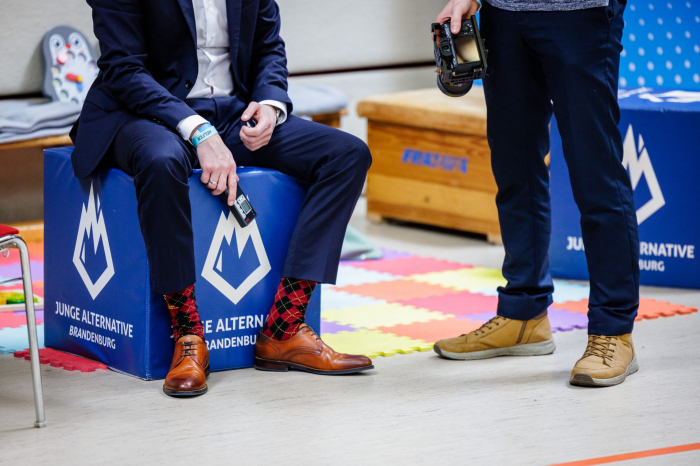“Daddy, tell me about the days when you were able to save Germany just in time,” a young girl asks her father as the two sit on the veranda of their idyllic home in an AI generated video by the youth wing of the far-right Alternative for Germany (AfD) party.
“It all started with the great remigration,” replies the father, birds chirping as they gaze out over their flowery garden. And then the dance beat kicks in.
This is the beginning of the video for “Remigration Hit,” a far-right dance track which imagines the deportation of migrants from Germany en masse. The widely shared video for the song portrays mostly blond-haired, blue-eyed pilots and flight attendants — embodying, it seems, delusive Nazi conceptions of “Aryan” racial purity — dancing in celebration as they deport people of color in planes decorated in the blue and red of the AfD.
“Now it’s time to go,” the chorus goes to a pulsing beat. “We’ll deport you all.”
Online campaigns like these have helped radicalize a broad swath of Germany’s youth, making extreme-right ideas that were once relegated to the margins of German political discourse increasingly mainstream. The Young Alternative, the AfD youth organization that put out the dance video, has been classified by Germany’s domestic intelligence agency as an extremist group since last year.
But that hasn’t stopped them and other extreme-right groups from spreading their ideology among Germany’s youth — with notable success.
In three state elections in eastern Germany last month, the AfD saw a surge in support among young voters, coming in first in all three states within that demographic and garnering between 29 percent and 38 percent of the vote among younger voters, according to exit polls.
“We are the party of the youth,” Hans-Christoph Berndt, the AfD’s lead candidate in Brandenburg, said on public television after the vote in that state. “The future is on our side.”
The phenomenon of young people gravitating toward the radical right is evident not only in eastern Germany, but across the country and in much of Europe. In the European election in June, the share of young people voting for the AfD in Germany rose by 11 percentage points to 16 percent — far surpassing support for the left-wing Greens, who once dominated in this demographic.
In France, Marine Le Pen’s National Rally party garnered about 30 percent of the youth vote in the European election — a 10-point rise compared to 2019. And in the Austrian national election last Sunday, the far-right Freedom Party (FPÖ) came in first not only in the general population — but also among voters aged 16 to 34.
Ahead of the federal election in Germany scheduled a year from now, the AfD, now polling second nationally, is hoping to emulate the FPÖ’s success in Austria, in part by reaching Germany’s youth.
In Germany’s last federal election in 2021, young voters flocked to the Greens and the pro-business Free Democrats (FDP). But addressing climate change, the Greens’ core issue, has faded in importance for many younger voters while the FDP has lost much of its image as a party that represents youth and innovation.
“Remigration” has become a commonplace talking point for the far right. | Volker Hartmann/AFP via Getty Images
Far-right groups are attempting to step into the void, and are growing increasingly adept at appealing to younger voters online.
The AfD was twice as successful at reaching first-time voters on TikTok in the run-up to Germany’s three state elections in September as all other parties combined, according to a study by researchers from the University of Potsdam. This group received an average of one TikTok video a day featuring AfD content, found the researchers, who analyzed over 75,000 videos on the social media platform in the weeks leading up to the elections.
“The discourse on social media is dominated by the right. That wasn’t always the case and is the result of years of work by these political parties and movements, who spent a lot of money to achieve this,” said Roland Verwiebe, one of the study’s main authors. “They have basically created a parallel, alternative media sphere that targets individuals very precisely.”
The far right’s ‘remigration’ dreams
Earlier this year, the revelation that AfD politicians took part in a clandestine meeting of right-wing extremists near the city of Potsdam in which “remigration” plans to deport foreigners and “unassimilated” citizens were discussed, sparked massive, sustained protests against the far right in Germany.
But just months later, “remigration” has become a commonplace talking point for the far right. The “remigration” talk now fails to spark similar shock and outrage “because the discourse in society as a whole has become so disinhibited and radicalized when it comes to the topic of migration,” said Johannes Kieß, a sociologist at the University of Leipzig.
That’s partly due to efforts of far-right activists to normalize the concept to Germany’s youth using unconventional means.
Another example of those means is a deportation-themed online video game called “Germany Rescuer,” which begins with a voice asking: “Can we still save Germany?”
Modeled on the well-known puzzle game Candy Crush Saga, “Germany Rescuer” urges players to rescue the country from “chaos” and “mass immigration” by, for instance, arranging an avatar of a black man to be put on a plane for deportation. Successfully matched rainbow flags that connote gay pride convert to German flags that yield national pride instead.
The game was created by the AfD’s youth organization.
“Hardly any young person would post a state election program in a WhatsApp group,” Anna Leisten, one of the leaders of the AfD’s youth wing in Brandenburg, said in an interview with a right-wing media outlet. “But a high score in a deportation game is much easier to share.”
More about:










-1745485667.jpg&h=190&w=280&zc=1&q=100)





































